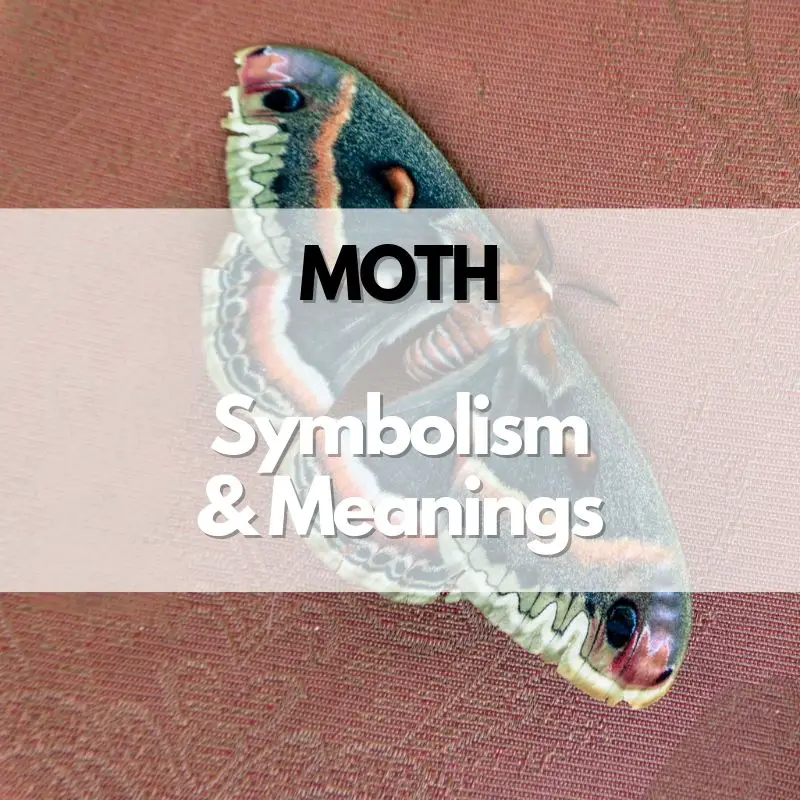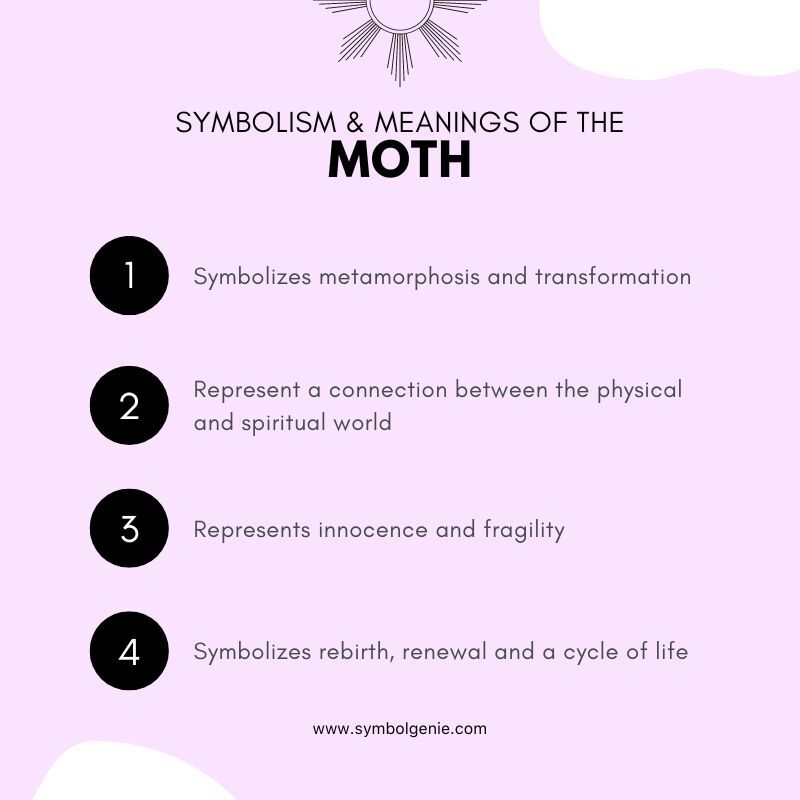Moth: Symbolism, Meanings, and History

Have you ever encountered a moth and wondered what it meant? Moths are often seen as symbols of transformation, hope, and new beginnings. In many cultures, moths are seen as omens of good luck. Keep reading to learn more about the symbolism and meaning of Moths.
The History of Moth
Moths are often thought of as simple creatures, but they actually have a rich history. Moths are found all over the world and play an important role in many cultures.
Moths are typically seen as pests, but they play an important role in the ecosystem. They are key pollinators and help to spread plant life. Many people don’t realize that moths are also an important food source for animals like bats.
Despite their bad reputation, Moths are actually quite beautiful creatures. They come in a variety of colors and patterns, and some even glow in the dark. Moths have been used as symbols in art and literature for centuries. Let’s look at the unique meaning, symbolism, and history of the moth.

Moth Symbolism and Meanings
Moths often get a bad rap. They’re seen as pests that invade our homes and destroy our clothes. But moths are actually quite fascinating creatures. They come in a variety of shapes, sizes, and colors and have many different symbolic meanings.
Here are some of the most common symbols associated with Moths:
- Transformation: Moths undergo a dramatic transformation during their lifetime. They start out as caterpillars, then transform into cocoons, and finally emerge as beautiful butterflies or Moths. This metamorphosis is often seen as a symbol of change or rebirth.
- Death: In many cultures, Moths are seen as symbols of death. This is likely because they are attracted to light and often end up flying into flames or candles, where they meet their demise.
- Mystery: Moths are often associated with mystery and the unknown. Their nocturnal habits and secretive nature add to this feeling of mystery.
As far as dream meanings go, dreaming of a moth generally symbolizes transformation, intuition, and personal growth. The moth may represent a powerful force within your life that is helping you to make changes and reach your goals. It could also represent a period of personal growth and self-discovery that is happening in your life. Alternatively, the moth may represent something that you are afraid of or feel threatened by.
Moth Spirit Animal
Moth spirit animals are often seen as symbols of transformation. They remind us that change is possible, and that we can adapt to new situations. Moths also represent hope and renewal. Their quiet beauty reminds us to take time to appreciate the simple things in life.
Spirit animals are totem animals that represent different aspects of our personality. They can be animals we identify with on a personal level, or animals that embody qualities we aspire to. We might also have a spirit animal that comes to us in times of need, or during periods of major life changes.
A Moth spirit animal can symbolize many things, including:
- Transformation: Moth spirit animals remind us that change is possible. They encourage us to let go of what is no longer serving us, and to embrace new beginnings.
- Adaptability: Moths are able to adapt to new environments and situations. This is a reminder that we have the same ability. We can always find a way to thrive, no matter what life throws our way.
- Hope: Moths represent hope and renewal. Their quiet beauty reminds us to take time to appreciate the simple things in life. Their presence is a reminder that even in the darkest of times, there is always light.
- Renewal: Moths are associated with renewal and new beginnings. They remind us that it is never too late to start fresh. No matter how dark and cold the winter months may be, spring will always come.
- Appreciation: Moths remind us to take time to appreciate the simple things in life. Their beauty is often overlooked, but it is there if we take the time to look.
Moth Totem Animal
Animal totems are believed to be spirit animals that represent certain traits and qualities that we possess. They are also said to be our guide, helping us navigate through life and connect with the natural world.
The history of animal totems dates back to ancient times when cultures all over the world would attribute certain animals to their gods and goddesses. In Native American cultures, animal totems were (and still are) used as a way to connect with the spirit world. Each animal has its own unique meaning and purpose.
The Moth totem is a gentle and delicate creature that symbolizes transformation. It represents new beginnings, change, and growth. The Moth teaches us to be open to change and to embrace the new. It also reminds us to be gentle with ourselves and others.
Moth in Religion & Mythology
The moth is mentioned in various religions, including Christianity, Hinduism, and Buddhism. In Christianity, Moth is seen as a symbol of death and resurrection. In Hinduism, Moth is seen as a symbol of reincarnation. In Buddhism, the Moth is seen as a symbol of impermanence.
Moth has been mentioned in various religions for centuries. In Christianity, Moth has been seen as a symbol of death and resurrection. In Hinduism, Moth has been seen as a symbol of reincarnation. In Buddhism, Moth has been seen as a symbol of impermanence.
The meaning of Moth in religion varies depending on the religion. In Christianity, Moth is seen as a symbol of death and resurrection. In Hinduism, Moth is seen as a symbol of reincarnation. In Buddhism, the Moth is seen as a symbol of impermanence.
Overall, the Moth is an important symbol in various religions. In Christianity, Moth represents death and resurrection. In Hinduism, Moth represents reincarnation. In Buddhism, Moth represents impermanence.
Moth Tattoo Meaning
Moth tattoos can be a great way to show your love of nature, and they can also be very pretty and feminine. There are a lot of different designs that you can choose from, and you can even get creative and design your own. Moth tattoos can be small and delicate, or they can be large and showy. Either way, they are sure to turn heads and start conversations.
Moth tattoos can be very simple, like a small moth on your wrist, or they can be very detailed and intricate. You can even get creative and have a Moth tattoo that is glowing in the dark. No matter what your style is, there is sure to be a moth tattoo that is perfect for you.
A Moth tattoo can symbolize a lot of different things. For some people, it can represent their love of nature. For others, it can represent transformation and change. And for some, it can simply be a beautiful and feminine tattoo. No matter what your reason is for getting a Moth tattoo, it is sure to be a beautiful and unique addition to your body art collection.
Moth Jewelry Meaning
Moths are often seen as pests, but they can also be seen as beautiful creatures. People have been making jewelry out of moths for centuries. There are many different types of moth jewelry. Some of the most popular types of Moth jewelry are necklaces, earrings, and brooches.
Moth jewelry is a great way to show your love for nature. Moth jewelry is also a great conversation starter. People will be drawn to your jewelry and will want to know more about it. Moth jewelry is a great way to express your personality.
Moths are often seen as symbols of change. They can also be seen as symbols of new beginnings. Moths are also seen as symbols of death. Moths in jewelry can represent all of these things. Moth jewelry is a great way to show your personality and express your beliefs.
Conclusion
Moth symbolism and meanings are often associated with death and darkness. However, moths can also symbolize new beginnings, transformation, and hope. Moths are often drawn to light, which can represent the search for knowledge or truth. As you can see, Moth symbolism is rich and varied. Whether you see a Moth as a positive or negative symbol, it is sure to provoke thought and curiosity.